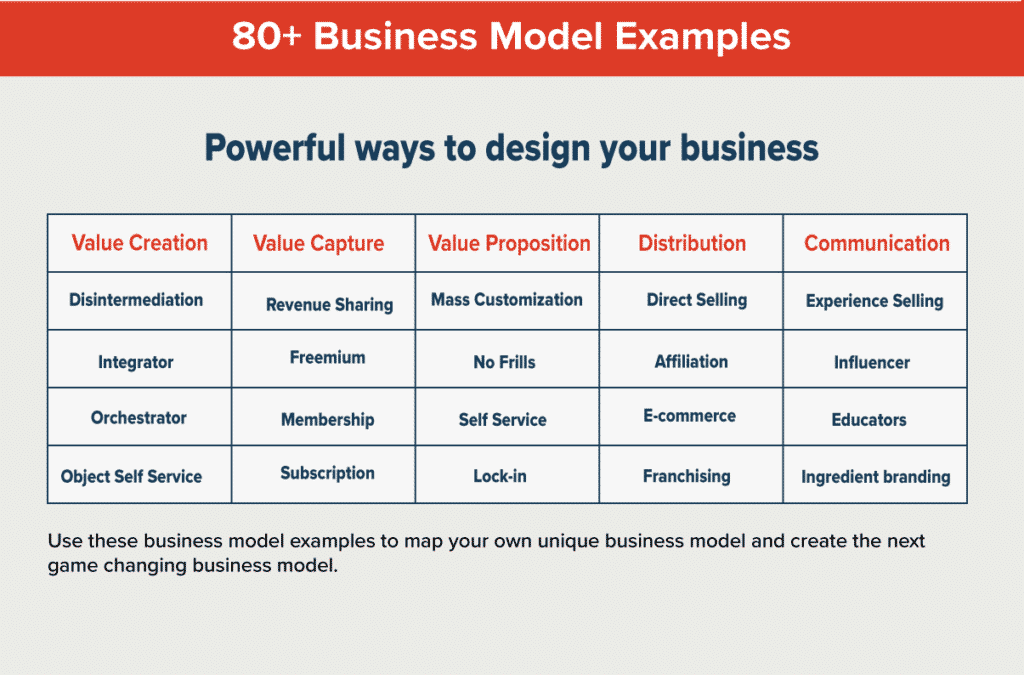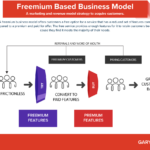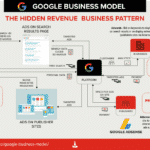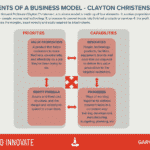Use these business model examples to inspire your own breakthrough innovative business.
Designing an innovative business model is the best way to create a long term competitive advantage.
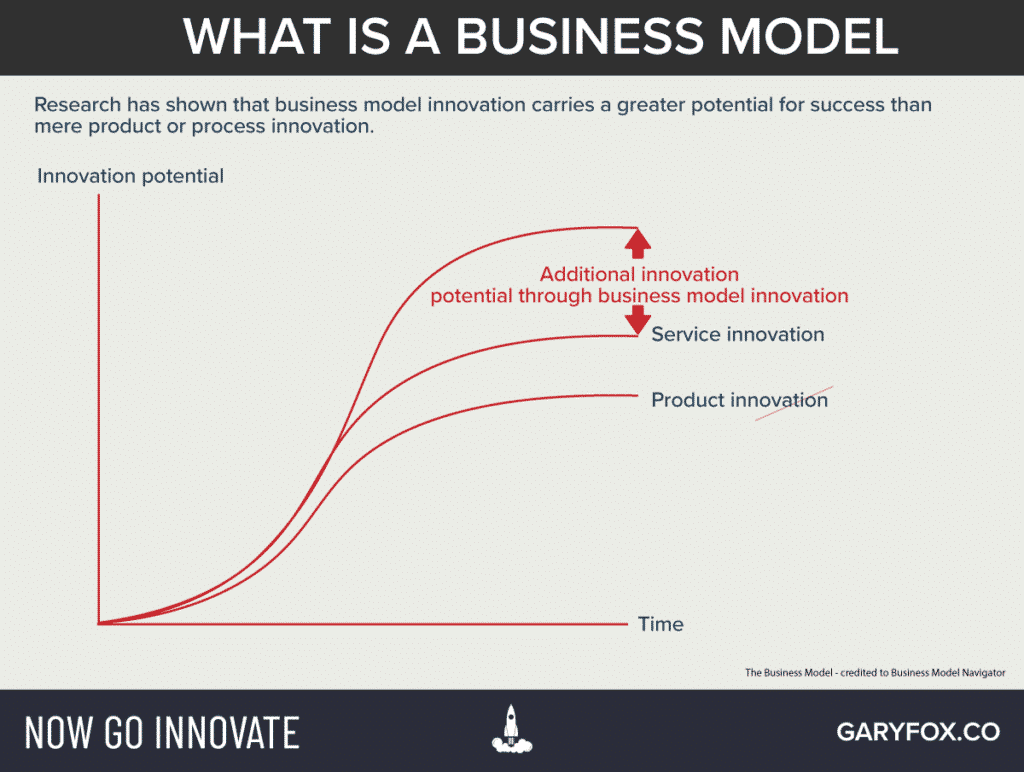
A business model can mean the difference between success and failure for new ventures.
Choosing the right business model then is key. In the early stages, teams need to iteratively generate business models and then evaluate them.
Business design is an essential strategic activity and requires management to reframe and rethink how they can compete. But business design also applies to startups, not just an intrapreneur.
The business model forms set the foundations for how you design your business, how you organize your resources, partnerships and how that then spills out in terms of your revenue model.
These business model examples demonstrate how different models have created economic moat for several companies.
Focusing on a business model though delivers long-term benefits:
- Business model innovation yields higher returns than product or service innovations 1Business model innovation: it’s not just about technology anymore. H. Chesborough. 2007. Journal of Strategy and Leadership.
- Established firms that innovate their business model experience improved performance results 2Business models, intangibles and firm performance: Evidence on corporate entrepreneurship from Italian manufacturing SMEs. Cucculelli, M., & Bettinelli, C. 2015. Small Business Economics.
Table of Contents
How To Use These business Model Examples
If your current business model isn’t performing, it’s time to make changes. When you’re designing or re-designing your business model, you need to take a systematic approach to explore and then exploit new opportunities:
Use The Business Model Framework
| BUSINESS MODEL SECTION | BUSINESS MODEL EXAMPLE |
|---|---|
| Value Proposition | Cross-Selling |
| Ultimate Luxury | |
| Lock-in | |
| Barter | |
| Value Creation | Integrator |
| Orchestrator | |
| Distribution | Direct Selling |
| Shop in Shop | |
| eCommerce | |
| Affiliates | |
| Value Capture | Franchising |
| Subscription | |
| Communication | Customer Loyalty |
| Experience Selling | |
| Ingredient branding |
The above examples are not an exhaustive list but a guide to how you can build your business model by thinking of where each example fits into the overall business design.
Before You Start
There are two critical approaches to business model innovation:
- Map the dominant business model(s) in your market.
- Design multiple business models that have the potential to compete and create greater long-term value.
- Evaluate the set of models and score them on ease of transformation and future value potential.
Challenge The Idea
Some questions to consider as you design your business models:
- Will the model generate superior margins to the competition?
- How easily can the business model be copied?
- Does the business model offer new customer segments?
- How will you get the breakthrough into new segments and what resources and investments are required?
Business Model Examples To Inspire You
This is a handpicked list of some of the latest business model examples.
Often, a business will use multiple types of business models to create its overall offer. You can too. Discover which business models are used by the leading companies such as Amazon, Facebook and many more.
In this list, there are some incredible examples of companies that radically changed their market by designing an innovative business model.
1. Freemium Business Model
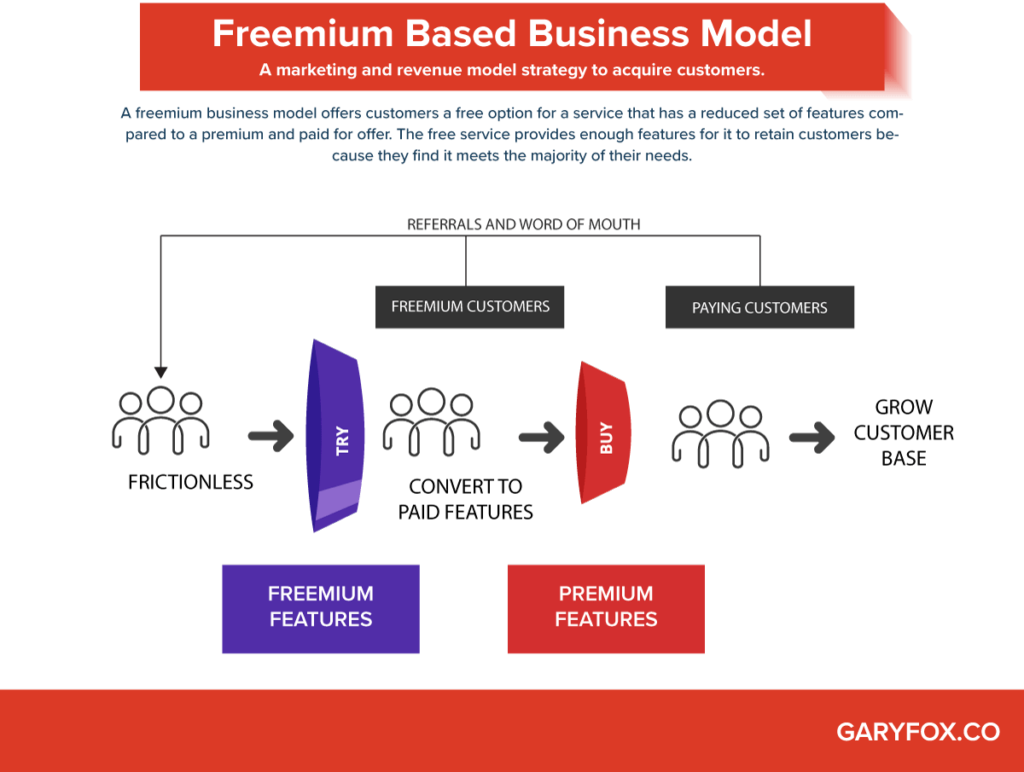
The freemium business model is popular among platform Software as a Service (SaaS) businesses. A freemium business model offers a free version of a product or service but with a limited set of features. To access a full set of features customers need to pay.
Why use the freemium model:
- free features are a potent marketing tool that actively moves people from prospects to potential customers.
- enables you to communicate and build a relationship with potential customers.
- customers get to try before they buy.
Examples: Spotify Business model, Mailchimp (free up to 2000 subscribers).
Related business models: subscription business model.
2. Ecommerce Business Model
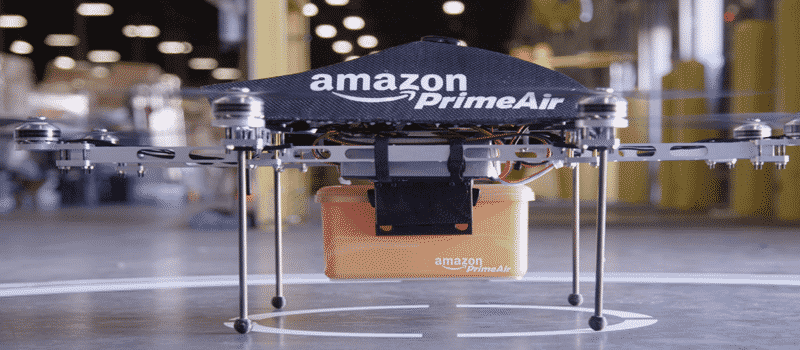
Ecommerce is one of the most popular and fastest-growing models. Worldwide eCommerce sales topped $3.5 trillion USD, an increase of approximately 18% from the year before. Ecommerce is expected to nearly double by 2023 to more than $6.5 trillion.
While we are all familiar with online shops, there are many more forms of e-commerce business models.
- B2B: Business to Business Ecommerce.
- B2C: Business to Consumer Ecommerce.
- C2C Ecommerce.
- C2B: Consumer to Business Ecommerce.
Examples: B2B (Alibaba), B2C (Amazon business model), C2C (eBay), (C2B) Upwork, Wish
Related business models: direct to consumer, brick and clicks, online auctions.
3. Razor and Blade Business Model
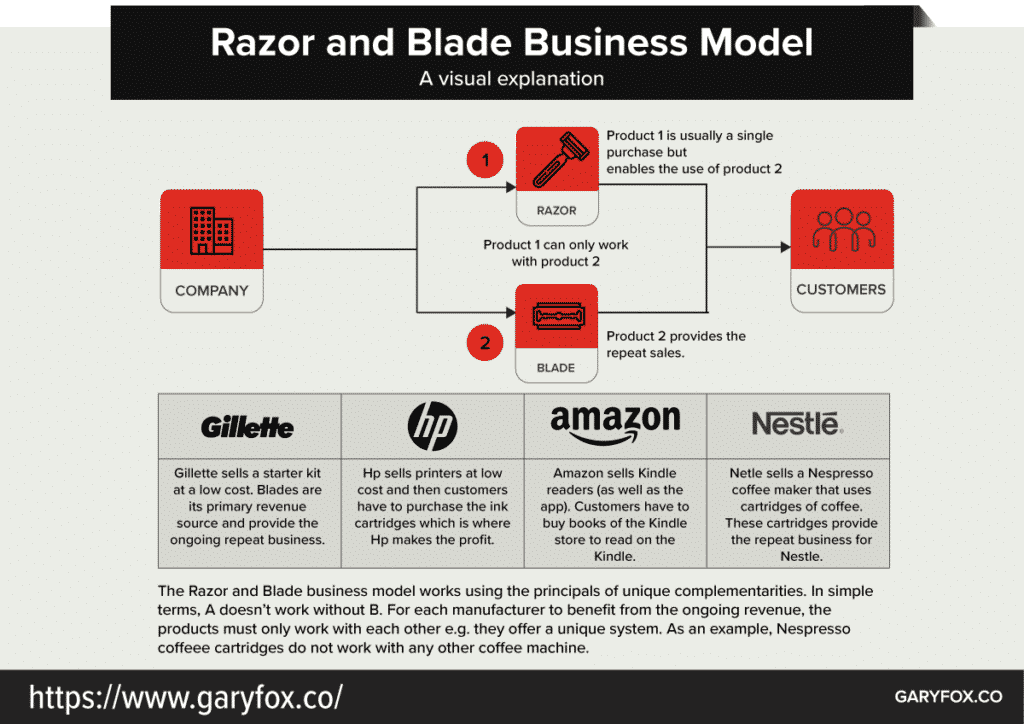
The razor and blade business model relies on the razor part only working with the blade. As an example, an ebook in Kindle format can only be used on a Kindle reader, a Nespresso cartridge can only be used in a Nespresso coffee maker. Some question its long-term viability as. business model 3 Razor-and-Blades pricing revisited, Business Horizons, Volume 59, Issue 3, 2016 .
The benefits of a razor and blade model are:
- Intellectual property protection offers companies a competitive advantage. Competitors are inhibited from copying their consumable goods process.
- repeat revenue and profits from the blade part of the equation.
Examples: Gillette – razor and blades, Nestle Nespresso – coffee machine and cartridges, Hp – printers and ink cartridges, Kindle reader and Amazon ebooks.
Related business models: direct to consumer.
4. Reverse Razor and Blade
In the razor and blades business model the main component, the razor is low-cost, and the blades are high cost. The reverse razor and blade model reverses that. The initial cost of the main component is high, but the consumables or “razors” are low cost.
- The value proposition is built on low-cost consumables – high volume.
- Easy to bundle items with the high-cost component.
Examples: Apple iPhones and Apple apps, movies, songs…
Related business models: direct to consumer.
5. Hidden Revenue Model
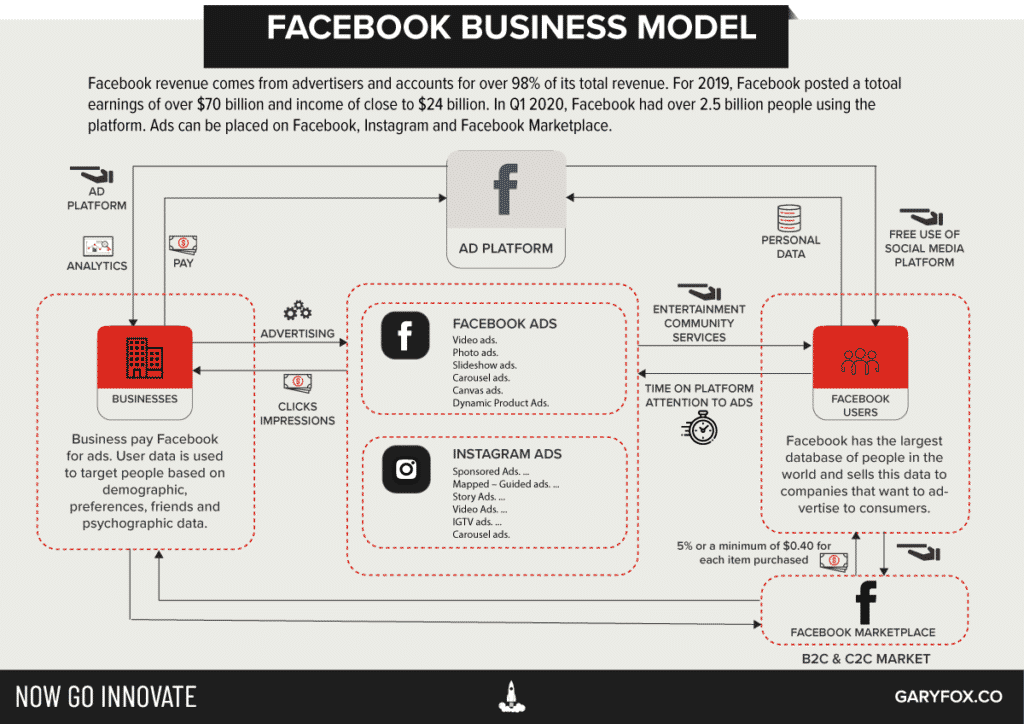
This model is most commonly seen with large scale advertisers such as Facebook and Google. In the hidden model, users do not pay for a service, instead, the revenue is generated from allowing advertiser access to the user base.
As an example, the Google business model generates the majority of its money from businesses using its ad platform.
Examples: Google, Facebook, Instagram, Snapchat.
6. Subscription Business Model
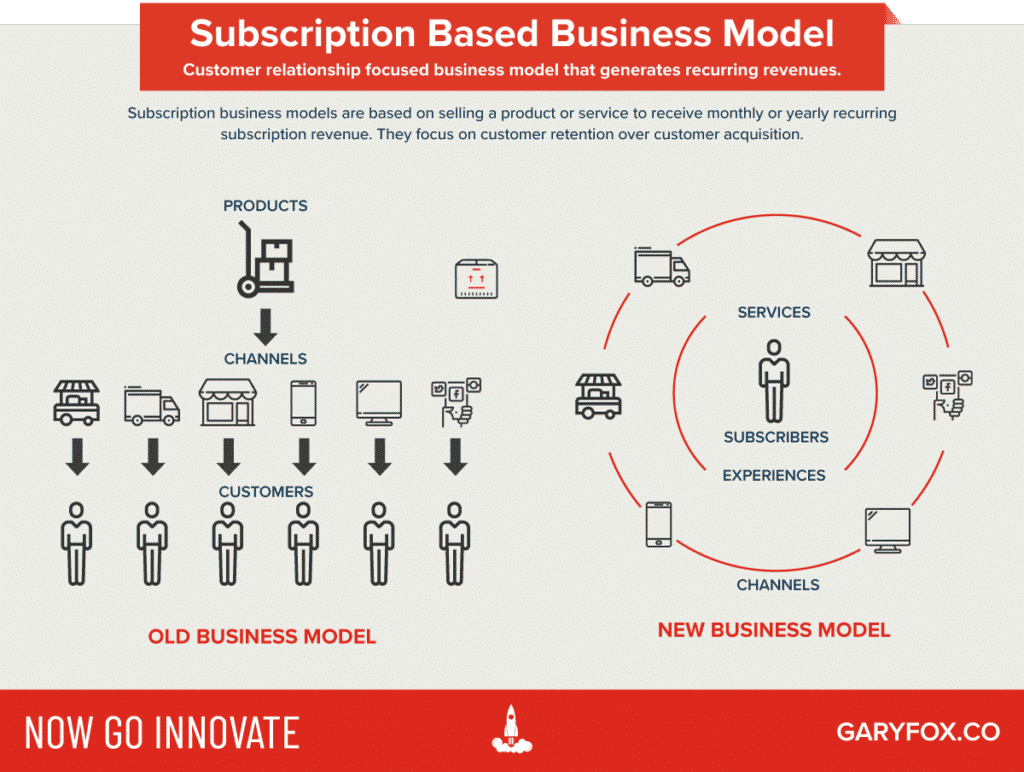
As services have grown more popular e.g. Software as a Service (SaaS), Infrastructure as a Service (IaaS)…so too has the popularity of the subscription business model. Most software platforms now such as Apple Music, Netflix and others use this model.
Business model examples: Dollar Shave Club, Netflix, Apple Music, Linkedin, Amazon Prime.
6. Cash Machine Business Model
The Cash Machine Model is also known as the Cash Conversion Cycle. It refers to how a company uses its buying terms with suppliers to ensure that it collects the cash for products before it has to pay suppliers.
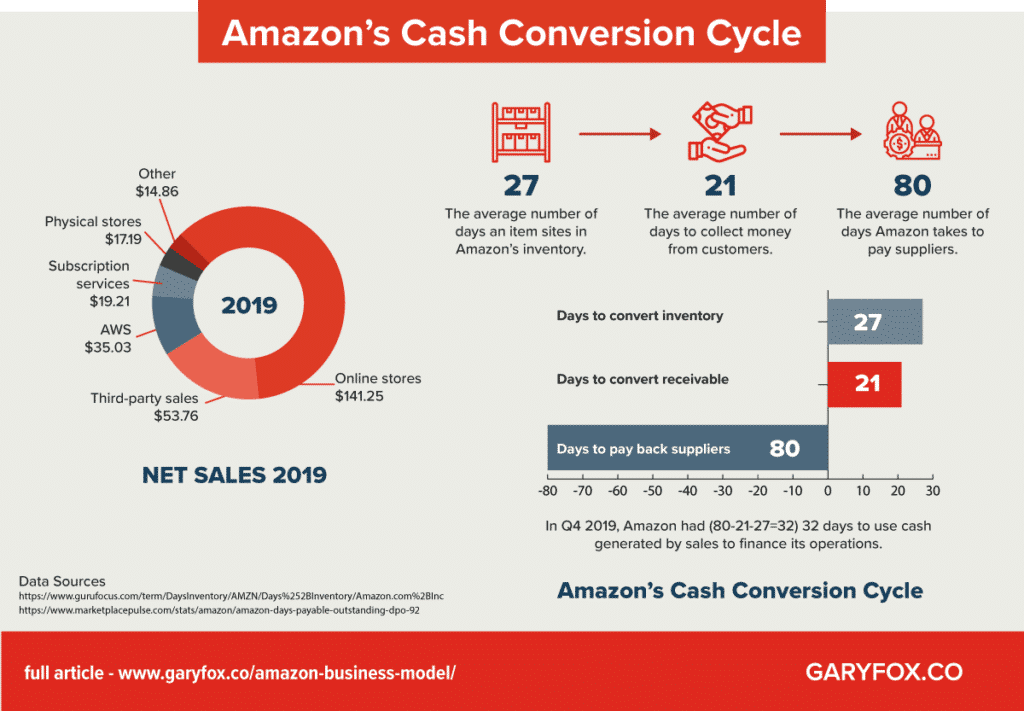
Business model examples: Dell, Amazon, Alibaba.
Related model examples: eCommerce, retail.
7. Franchise Business Model
A franchise model is where the central operations create the demand for a product or service and then the operations are run by franchisees. The central office takes a percentage of the profits to fund marketing, operations and contribute to the central profits.
Examples: McDonald’s, Pizza Hut, Subway, Gold’s Gym.
Related business model examples: retail, subscription.
8. Affiliate Marketing Model
With affiliate marketing a person or business makes money by referring, recommending and promoting a product or service. The producer of the product/service saves in advertising costs and instead uses this money to pay a commission to affiliates.
- In using this model you need to ensure affiliates are vetted to ensure alignment with brand and customers.
- Support and guidelines are given to help affiliates successfully promote brand e.g. graphics.
Business model examples: Amazon affiliates,
9. Agency Business Model
An agency manages projects or tasks on behalf of a client. As an example, a company may outsource certain activities to agencies that have specialist skills and expertise. Apple, for instance, outsources its advertising to TBWA a global advertising agency. An agent can also be an individual who facilitates tasks such as managing projects.
Examples: PR Agency – Edelman, Advertising agency – TBWA
Related business model examples: broker.
10. Disintermediation
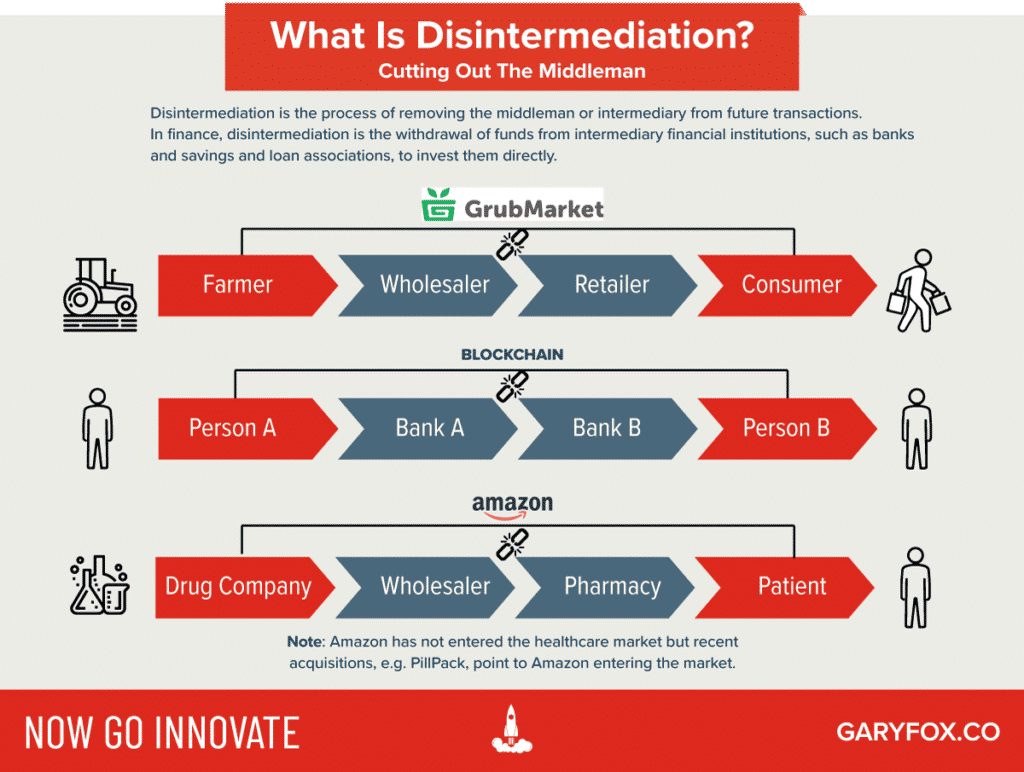
Disintermediation is also known as cut out the middle man simply because you eliminate part of the supply chain. This saves on costs and/or allows others to take a higher margin. Either way, it is a disruptive model that often leaves many incumbent companies with problems as they try and adjust.
Examples: Grubmarket, Bitcoin (cryptocurrency – cuts out banks)
11. Reverse Innovation Business Model
In developing countries, lower-income levels demand that manufacturers reverse engineer the products to make them simpler and therefore less expensive. However, as a result, they are often then introduced into developed (industrial) countries where they serve the needs of a lower income base.
Examples: General electric – logan, Tata Swach, Renault Logan
12. Solution Providers
A solution provider offers end-to-end services within a specialist area. The goal for a service provider is to become a one-stop-shop for everything that a customer needs. Quite often this requires a blend of technology, people and other resources to achieve. This business model is often used with complex and high-technology sectors e.g. aviation.
Examples: Rolls Royce, SAP, Cisco.
13. Auction Business Model
At an auction, a product is sold to the highest bidder. All auctions work the same way, an item is listed and then within a time frame all bids are made and whoever bids the most wins. This allows a seller to optimise the value of a product given a set of buyers.
Examples: eBay, Google (Google uses a bidding system for ad placements).
14. Peer-to-Peer
This model relies on people to people or peer-to-peer transactions and exchanges. Usually, platforms facilitate the trust between people as well as enable the transactions to take place.
As an example, PayPal allows people to send money to each other. A further example is Craigslist, where people can list items for sale.
Examples: PayPal, Craiglist, Facebook Marketplace
15. Unbundling Business Model
Unbundling is the opposite of bundling. It is a model that works by unpacking products and making it easier for customers to just select and buy what they want.
As an example. Apple unbundled the music album by offering its customers on iTunes the ability to buy just one song rather than a whole album.
Examples: Apple Music, Google unbundled Newspapers by allowing people to read the content they want.
Related business model examples: bundling, eCommerce, digitalization.
16. Crowdfunding
Crowdfunding can be used to gain finance for a project, product or a startup. Crowdfunding became scalable as a result of online platforms that immediately connected hundreds of thousands of people to a host of projects that were looking for funds.
Examples: Kickstarter (crowdfunding platform), Patreon.
Related business model examples: crowdsourcing, open innovation.
16. Experience Selling

Some companies have successfully transitioned to experience brands and in doing so become iconic and more valuable. Experience selling is how they have achieved results beyond any normal brand equity.
Experience selling is when customers enhance their brand and product by focusing on the design and delivery of superior customer experiences. This means that the companies excel at delighting customers at every part of their customer journey. Furthermore, they encourage and connect their customers to enable them to create word of mouth referrals which further enhance the brand. these brand champions go onto to become advocates for the brand and its products.
Examples: Harley Davidson, IKEA, Red Bull.
Related business model examples: E-commerce, direct selling, subscription
17. Ingredient Branding Model
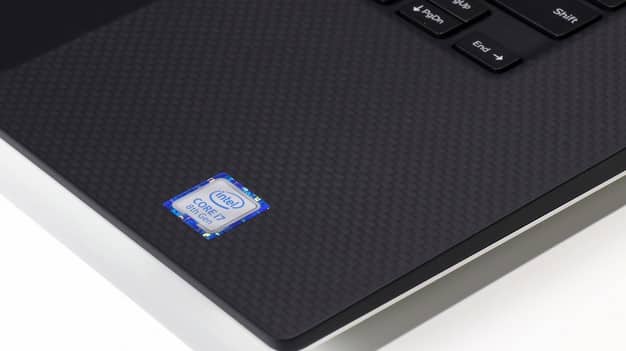
Ingredient branding is where a component from one brand is added to another product but the branding remains visible. This is quite often the case for B2B2C models.
The final product, with the ingredient product, improves the perceived value to the customer.
Examples: Microsoft (Office products included with laptops and PC’s), Intel (branding is associated with quality and speed of laptops/PC’s).
18. Aggregation
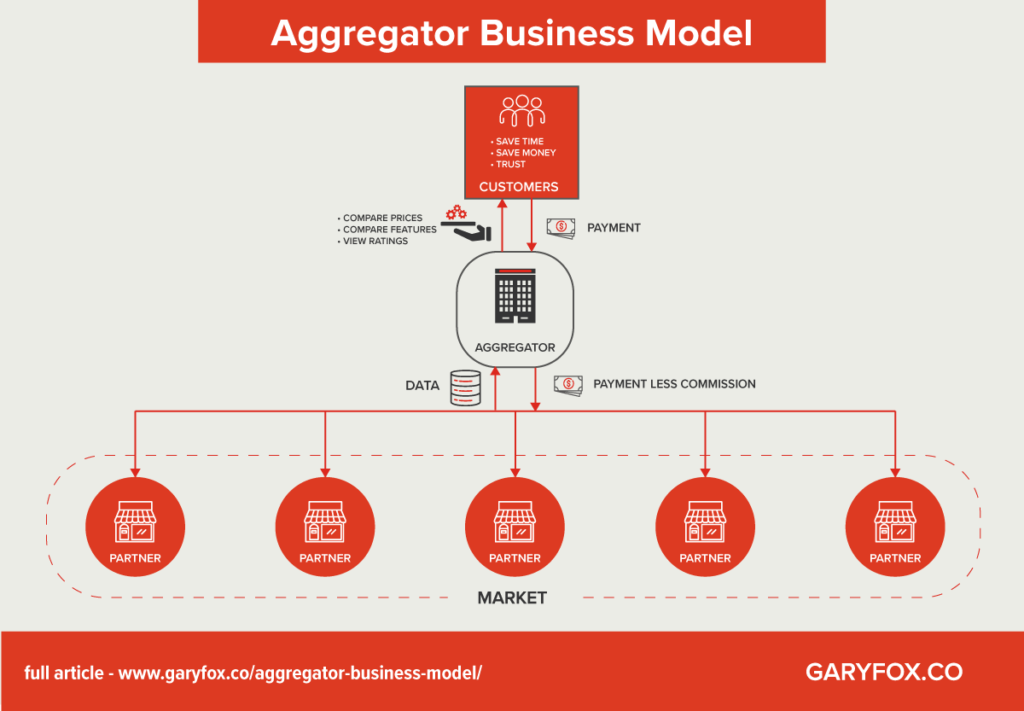
An aggregator business model is where a company bundles other services or products under its own brand. The company then earns money through commissions.
Examples: Uber, Airbnb, Oyo, Setapp.
Related business model examples: eCommerce, subscription, pay-per-use.
19. Layer Player
A layer player is a company offers value within one particular part of a value chain. This step is typically offered within a variety of independent markets and industries.
The business benefits from economies of scale and becomes more efficient as it scales. Moreover, becoming an expert can result in a higher quality process and margins.
Examples: ARM, Amazon AWS, Google Cloud, Microsoft Business Model
20. License Business Model
There are many different forms of license model. Many involve licensing of intellectual property to those that need to use it. This model, therefore, relies not on the development and then exploitation of knowledge in the form of products and patents. Typically, firms that focus on research and development subsequently seek patents that allow them to commercialize and scale revenues. this is typical as an example within the pharmaceutical industry.
Examples: SAP, IBM.
21. Mass Customization
Customizing products used to be an impossibility in the days of factories. But technology has enabled things to be produced in more modular ways and that in turn has led to mass customization. Modular products and production systems are now commonplace and offer individualization of products. As a consequence, customer can tailor products to their own requirements.
Examples: Netflix, Apple iPhone, Nike, Subway, Doordash.
Related business model examples: eCommerce, digitalization, platforms.
22. Pay Per Use
In this model, the actual usage of a service or product is measured and a customer only pays for what they use. This is the opposite of a lockin and appeals to customers who may have varied usage needs at different times or need to gradually scale.
Examples: Amazon AWS, Google Cloud, Car2Go.
23. Shop In Shop
For a shop-in-shop, a brand chooses a partner who has branches that can offer space for the brand to sell its products. Normally, the two brands align in terms of customers and therefore both parties benefit from customers in the host hop. Amazon has taken this model and made it digital, now brands have their own custom shops in the Amazon store.
Examples: Nestle Nespresso, Levi’s.
Related business model examples: eCommerce, retail, bricks and clicks.
24. Direct To Consumer (D2C)
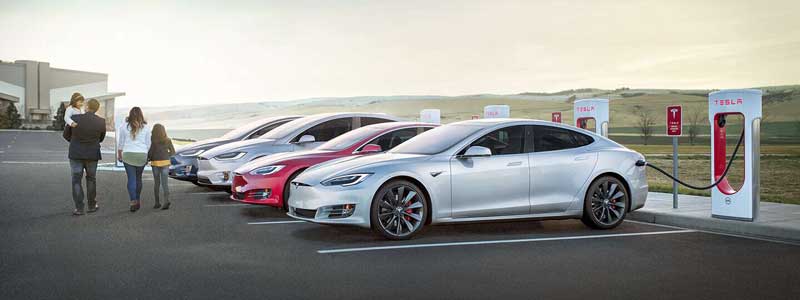
Direct to Consumer, sometimes referred to as direct selling, is a model where products are not sold through intermediate companies such as retailers or through wholesalers. Instead, the company sells directly to the end-user.
Emarketer, for instance, forecasts that D2C eCommerce sales will rise to $17.75 billion in the US by 2021.
Examples: Dollar Shave Club, Casper, Abel and Glossier Cosmetics, Wish.
25. Target The Poor
The product or service offering does not target the premium customer, but instead, the customer at the base of the pyramid.
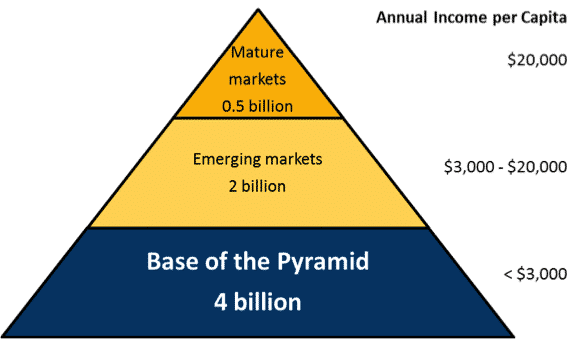
Customers with lower purchasing power benefit from affordable products. The company generates small profits with each product sold, but benefits from the higher sales numbers that usually come with the scale of the customer base.
Examples: Aldi, HomeBuy.
Related business model examples: reverse innovation, reverse engineering
80 Business Model Examples Infographic

